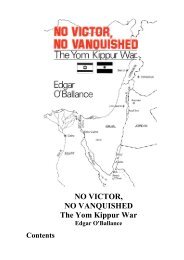israeli fortifications of the october war 1973
israeli fortifications of the october war 1973
israeli fortifications of the october war 1973
Create successful ePaper yourself
Turn your PDF publications into a flip-book with our unique Google optimized e-Paper software.
ISRAELI FORTIFICATIONS<br />
OF THE OCTOBER WAR <strong>1973</strong><br />
The combination <strong>of</strong> Israeli air<br />
power and armoured might<br />
was <strong>the</strong> key to victory in <strong>the</strong> Six<br />
Day War. In <strong>the</strong> words <strong>of</strong> <strong>the</strong><br />
<strong>war</strong> correspondent Randolph<br />
S. Churchill: 'a feat <strong>of</strong> arms<br />
unparalleled in all modern<br />
history'. Nei<strong>the</strong>r <strong>the</strong> Arabs nor<br />
<strong>the</strong> Israelis were able to find<br />
any political accommodation<br />
following <strong>the</strong> conflict leading<br />
to renewed hostilities and <strong>the</strong><br />
creation <strong>of</strong> extensive field<br />
<strong>fortifications</strong> along Israel's<br />
vastly expanded borders.<br />
4<br />
'Ifyou entrench yourselfbehind strong <strong>fortifications</strong>, you compel <strong>the</strong> enemy<br />
to seek a solution elsewhere.'<br />
Karl von Clausewitz, On War<br />
ONLY LET THERE BE PEACE<br />
The Six Day War <strong>of</strong> June 1967 was possibly <strong>the</strong> most stunning victory in <strong>the</strong><br />
annals <strong>of</strong> modern military history. Only a week previously, many Israelis<br />
believed <strong>the</strong>ir country to be on <strong>the</strong> eve <strong>of</strong> destruction on a par with <strong>the</strong><br />
Holocaust. Surrounded by a hostile Arab world, Israel faced invasion from<br />
<strong>the</strong> armies <strong>of</strong> four separate nations. Yet within six hours, <strong>the</strong> Israeli Air Force<br />
(IAF) destroyed <strong>the</strong> military and political will <strong>of</strong> <strong>the</strong>se implacable enemies.<br />
Within six days, <strong>the</strong> Israel Defense Forces (IDF) comprehensively destroyed<br />
<strong>the</strong>ir armed forces and changed <strong>the</strong> political complexion <strong>of</strong> <strong>the</strong> Middle East<br />
to this day. Before <strong>the</strong> <strong>war</strong> <strong>the</strong>re was a rueful Israeli saying that went: 'Israel<br />
is like a sausage - easy to carve up.' In an overwhelming triumph <strong>of</strong> arms, <strong>the</strong><br />
Israelis increased <strong>the</strong>ir landmass by a factor <strong>of</strong> four and achieved militarily<br />
defensible borders for <strong>the</strong> first time since <strong>the</strong> creation <strong>of</strong> <strong>the</strong> state in 1948. In<br />
<strong>the</strong> euphoria <strong>of</strong> victory, Israeli confidence knew no bounds and a new saying<br />
was heard in <strong>the</strong> cafes <strong>of</strong> Tel Aviv and <strong>the</strong> newly captured city <strong>of</strong> Jerusalem:<br />
'Damascus is just an hour away, Cairo perhaps two.'<br />
Vital terrain was gained on <strong>the</strong> West Bank <strong>of</strong> <strong>the</strong> Jordan River, <strong>the</strong> Golan<br />
Heights and <strong>the</strong> Sinai Peninsula. Yet <strong>the</strong>se greatly extended borders now had to<br />
be defended against an Arab world that would not countenance any form <strong>of</strong><br />
political or territorial compromise except an immediate return to <strong>the</strong> borders<br />
ante-bellum. The prospect <strong>of</strong> lasting peace seemed as elusive as ever. The defence<br />
<strong>of</strong> <strong>the</strong> occupied territories was now a pressing reality. The strategic depth<br />
afforded by <strong>the</strong> Sinai Peninsula demanded its total retention but with <strong>the</strong><br />
minimum <strong>of</strong>forces given Israel's chronic shortage <strong>of</strong> manpower as compared to<br />
her Arab neighbours. Similarly <strong>the</strong> Golan Heights was vital ground to be held<br />
at all costs. The dilemma was how to achieve <strong>the</strong>se aims with <strong>the</strong> least<br />
expenditure <strong>of</strong> men and resources. Fortunately, <strong>the</strong> rugged terrain on both <strong>the</strong><br />
Golan Plateau and <strong>the</strong> Sinai Peninsula favoured <strong>the</strong> defenders, since both were<br />
predominately mountainous with few roads to aid any attacker. The only<br />
feasible avenue <strong>of</strong> attack was across <strong>the</strong> Suez Canal, yet <strong>the</strong> waterway itself<br />
presented a formidable obstacle that would have to be surmounted first before<br />
any assault could be successful. The Israelis had no intention <strong>of</strong> allowing this to<br />
happen. The outcome was <strong>the</strong> War <strong>of</strong> Attrition. With <strong>the</strong> resumption <strong>of</strong><br />
hostilities in July 1967, <strong>the</strong> fortification <strong>of</strong> <strong>the</strong> IDF positions along <strong>the</strong> Suez<br />
Canal became necessary to reduce casualties. This led to <strong>the</strong> construction <strong>of</strong> <strong>the</strong><br />
fabled Bar Lev Line. It was just one element in an increasingly sophisticated<br />
defence strategy that had all <strong>the</strong> hallmarks <strong>of</strong> a complex three-dimensional chess<br />
game, albeit a contest that frequently resulted in <strong>the</strong> deaths <strong>of</strong> soldiers and<br />
airmen in <strong>the</strong> ever-shifting sands <strong>of</strong> <strong>the</strong> Sinai Desert and <strong>of</strong> sailors in <strong>the</strong> waters<br />
that defined <strong>the</strong> Sinai Peninsula. To extend <strong>the</strong> chess analogy fur<strong>the</strong>r, <strong>the</strong> static<br />
Bar Lev Line represented <strong>the</strong> line <strong>of</strong> pawns on <strong>the</strong> board <strong>of</strong> battle. Behind <strong>the</strong>m,<br />
<strong>the</strong> artillery acted as rooks capable <strong>of</strong> rapid linear movement along <strong>the</strong> front<br />
and providing heavy firepower at every point <strong>of</strong> contact. The Israeli Armored<br />
Corps (IAC) provided <strong>the</strong> bishops, capable <strong>of</strong> rapid movement and shock action<br />
Victory in <strong>the</strong> Six Day War<br />
brought <strong>the</strong> IDF to <strong>the</strong> banks<br />
<strong>of</strong> <strong>the</strong> Suez Canal where<br />
troops dug in, such as this<br />
machine-gun team with <strong>the</strong>ir<br />
.30-cal. M1919 Browning as a<br />
Sikorsky S-58 helicopter comes<br />
in to land. Such basic positions<br />
provided scant protection<br />
against Egyptian artillery fire<br />
and as <strong>the</strong> casualties rose <strong>the</strong><br />
Sikorsky S-58 helicopters were<br />
Widely used in <strong>the</strong> medical<br />
evacuation role. First acquired<br />
in February 1958, <strong>the</strong> Sikorsky<br />
S-S8 helicopter equipped IAF<br />
No. 124 Squadron 'Rolling<br />
Sword' and 28 were in service<br />
at <strong>the</strong> outbreak <strong>of</strong> <strong>the</strong> Six Day<br />
War when <strong>the</strong>y acted in <strong>the</strong><br />
search and rescue (SAR) role<br />
for downed pilots, air assault<br />
<strong>of</strong> Israeli paratroopers, tactical<br />
airlift and for aeromedical<br />
evacuation missions. By 1969,<br />
<strong>the</strong> S-S8 had been superseded<br />
by <strong>the</strong> Bell 205 in <strong>the</strong> SAR role.<br />
5




